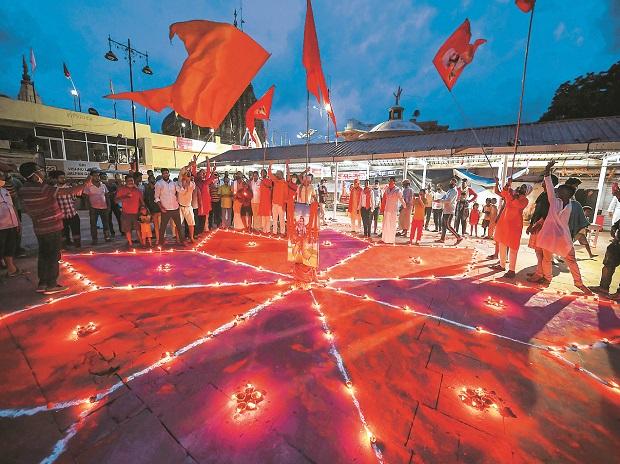Neglecting Adivasi deities, rituals and culture, the Gujarat government announced an aid of Rs. 5000 to tribals for a trip to the Ram temple in Ayodhya. Adivasi leaders said the scheme is aimed at wooing and consolidating the tribal population as Hindus ahead of the 2022 Assembly elections in Gujarat.
Mitesh Vasava | TwoCircles.net
GUJARAT – Tribal leaders and Adivasi residents of the Narmada region strongly objected to the Gujarat government announcing a financial aid scheme for Adivasis for visiting the Ram temple in Ayodhya from funds that are allocated for the development and welfare of the tribal population in the state. They alleged that ahead of the coming state Assembly elections, the Gujarat government was trying to saffronize tribals to turn them into a vote bank for the ruling party.
The State government last month announced special financial aid to the tribal population of Gujarat for a trip to the Ram Janmabhoomi in Ayodhya. A tribal person in Gujarat can claim Rs 5,000 for the trip to Ayodhya if he/she can show evidence of ‘Ram Lalla darshan.’
That this scheme is a part of the tribal development and welfare program of the state government, came as a complete shock for the tribal leaders.
Several Adivasis TwoCircles.net talked to were appalled by the government spending millions of rupees from funds intended for tribal development to sponsor a religious trip to a Hindu religious site which has nothing to do with Adivasi culture. They highlighted the “misplaced priorities” of the state government as Adivasi regions which don’t have sufficient facilities for health and education.
Nagin Bhai Rathwa, a community leader, highlighted the increasing efforts of Hindutva organizations like Rashtriya Swayamsevak Sangh (RSS), Vishwa Hindu Parishad (VHP) and Bajrang Dal, to saffonize the tribal population in the state, have paid off.
“While Adivasi cultural practices are vanishing fast, there is the substantial and palpable influence of Hindu Gods, cultures and festivals in tribal regions. A section of Adivasis joining these Hindutva groups has influenced the tribal customs,” said Rathwa while giving several instances to prove his point. Ganesh Chaturthi, which was never celebrated a decade ago, is celebrated in every region of the Chhota Udaipur district. Hindu festivals like Navratri Garba were not celebrated at a sacred place like the Rani Kajal (deity of rain) temple till 2005.
“Misplaced priorities of Gujarat government”
For twenty-six years old Bhadresh, who is the sole breadwinner in the family of five, the Ram temple pilgrimage scheme “didn’t make sense.” “I work 24×7, seven days a week to make ends meet. I follow the Adivasi deities as well as Hindu gods, but this pilgrimage is not on my priority list. I have to sort out a long list of problems for my family before going on a pilgrimage,” said Bhadresh, an accountant living in Jetpur village of Narmada district.
Hitesh, a youth who works as a daily wage worker in Nandod taluka of Narmada district, said that he visited prominent temples. But he would prefer if “the government utilises this fund for family welfare purposes.”
Unemployment is such a major problem for Adivasi youths. So much so that a large population are daily wage workers, underpaid in between Rs 100 to 150/daily. Most of them work in road and housing construction projects or sugar mills. They don’t have access to affordable health care. In the post-Covid era, inflation, and the agrarian crisis has pushed the tribal population to poverty. That is why for Jayesh, a 24 years-old social worker, this financial aid scheme was nothing but “an attempt to saffronize the tribal population” ahead of the next year’s state elections.
“The state government should build hospitals, schools and colleges for Adivasis. But it won’t do that. Instead, it has introduced a useless scheme like this to radicalize and saffronize the Adivasi region,” he said.
“The state government is hell-bent on replacing the Adivasi culture by an Adivasi population which is a follower of Hindutva. Why else is it not recognizing and promoting Adivasis culture? Why do Adivasi students have to bribe up to Rs 3000 to get a caste certificate? Why isn’t the government building resources for structural change in the Adivasi regions?” Jayesh questioned.
“Adivasi regions are not properly developed anyway. To make the matter worse, the money which should be used for the construction of schools and hospitals in tribal regions will be used to turn Adivasis into Hindutva followers by sending them to a religious place that has nothing to do with them,” he said.
Aimed at consolidating tribals as Hindus
Jayesh said the scheme is aimed at wooing and consolidating the tribal population as Hindus ahead of the 2022 Assembly elections in Gujarat. Tribals are crucial to BJP’s strategy to win the state as they make up nearly 15% of Gujarat’s population, higher than the national tribal population share of 8.6%. As many as 27 of the 182 seats in the Gujarat assembly are reserved for tribals. The tribal vote is significant in another 14 constituencies. Apart from these, Chhota Udepur, Dahod, Bardoli and Valsad are four parliamentary (Lok Sabha) seats reserved for tribals. Congress has 13 tribal MLAs and the BJP has 11.
“The non-Adivasi RSS leaders recruit Adivasi youths as foot soldiers. And as the state elections are coming closer, there is a higher possibility that the government will use its Hindutva tactics to increase their vote bank in the region.”
Mitesh Vasava is a SEED fellow with TwoCircles.net.


